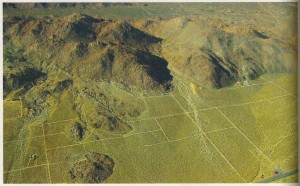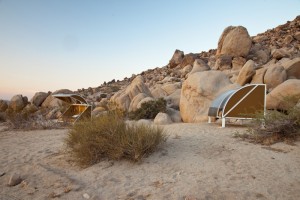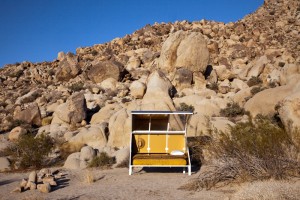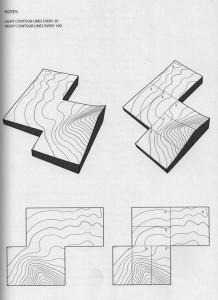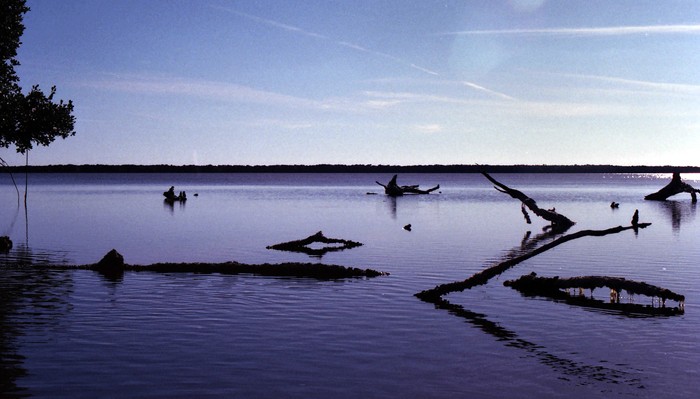
Prospect by Cara Despain
It’s quite a thing to see the sea meet the sky: two profoundly different systems converging at a single line. With nothing but water and atmosphere, this seems the true way to understand the planet’s shape—after all, its surface is comprised mostly of these materials. No wonder there was a period of second-guessing the spherical model. There’s no real way to intuit that you might actually be standing sideways on an immense conglomerate ball of interstellar material, bound only by gravity. That really can only be (abstractly) understood when you see the Earth from an external perspective—one that looks different than yours from the ground; something like what the Charles and Ray Eames’ Powers of Ten film illustrates. From this baseline—sea level, maximum flatness—the physical character of the Earth’s landmasses is increasingly complex. Geologic forces have created, destroyed and ultimately sculpted the topography that contains every last landscape the history of art could possibly romantically depict. But this came after the practical effect those topographies had on migration, settlement and ultimately culture. You can look at things like tools, clothing, transportation modes, biological adaptation and shelter and locate peoples’ history in landscape. That is the larger story. Does any of this formation resound in the practices of artists now at different elevations? Excavating and sifting histories, tracing influences, and drawing lineages is like panning for gold. Patience, trained eyesight, and a determination to make the trek are requisite. In the context of current human existence, one that is free floating in an increasingly gravity-less, shapeless world—the liminal zone of endless images, links and information of the Internet and the infinite sub-microcosms that ensue—discerning such distinctions and characteristics is difficult. Living in non-space as much as we do, especially in the art world where, on top of spending so much time in nondescript white and concrete (often windowless) interiors, we absorb content such as installation views, reviews, and Instagram images of other art shows instantaneously, we are bound to start to lose some colloquial sense of location. These are places largely without a relationship to a physical place. How do you understand the ground without walking on it?
I was born and raised at approximately 5,000 feet, nestled in the Rocky Mountains of Utah, and I now reside at an altitude of zero feet, surrounded by the sky and ocean in Florida. The difficulty and reward in conquering the western American frontier was the Rockies. They were hard to cross and striking to observe, and inspired scores of landscape painting and photography traditions—which only perpetuated exploration and the underlying promise of proprietorship. Transiting tough passages in covered wagons certainly had a lasting impact on culture—the resulting Mormon Pioneer folk music has an entire history all its own, for example, and certain kinds of folk aesthetics related to craft and function have persisted in the West generally, and morphed into new forms with the passage of time. Now many of those same forged routes are permanently etched into the land in the form of road cuts made for highways, solidifying our presence and easing our ability to travel freely without having to make many terrain-based considerations. In Florida, elevation had to be constructed. The southernmost tip of the state is sub-tropical swampland that despite the year-round temperate weather was rather inhospitable for settlement. Natives would build up mounds out of discarded shells and bones to raise themselves above the water level. This conceivably also would offer more prospecting possibility. Though the necessity and intention was quite different, the modern, paradise-seeking settlers that followed in the wake of the Standard Oil industrialist Henry Flagler followed suit. Today, to obtain a view in South Florida you must have access or class, as high-rise condos stand as the tallest landmarks in the modern landscape. Going from a varied terrain where the effects of gravity, erosion, and scale are unavoidable to a place defined by its unrelenting flatness, I think a lot about the specific subject of topography. I hear a difference in the music bands play, and see a difference in the architecture and lifestyle. As an offshoot of my interest in regionalism in contemporary art and aesthetics, I wanted to look at the role the actual shape of the land might play. As a topic for this Journal, it is a focused but widely inclusive receptacle for histories and perspectives as they relate to culture and its attendant objects and artifacts. Physical topographies belie social topographies, and the view shifts with the vantage point.
Within topography and elevation exist many corollaries to culture; those cannot all be tackled here. I hope to offer a few examples that come naturally, and look at a practical dimension of landscape that shifts and extends the conversation to relate to deep time, geology and our experience in that continuum. All of the contributors I have invited have a practice that is deeply outdoors, and this means what they experience out there becomes a part of their artwork and expertise. When indoors, Hikmet Sidney Loe lectures regularly on the Land art of the American West, but this is informed by firsthand, sometimes disorienting and difficult jaunts. David Brooks, an artist/naturalist hybrid whose research locales have spanned Africa, the Everglades and the Amazon, offers a discussion that probes a compressed and buried ancient topography of the oil-laden lands of Texas. Xaviera Simmons has traveled different migration routes by foot, taking her all over the world, and additionally has worked remotely to capture many of the landscapes that comprise or inform her works. Physically transiting landscapes means dealing with the reality of those places, not just interpreting them as pictures—which are two vastly different types of engagement that can be historically evidenced where depicting landscape and the sublime are concerned. The intention here is to go deeper into contemporary notions of landscape by simplification—perhaps in part by just talking about being there.
Altitude alone has biological implications: it has affected the pulmonary development of different peoples (such as high-altitude Andean cultures) and, as recent research by a University of Utah neuroscientist comparing suicide rates in high-altitude regions even suggests, it continues to have an impact on brain chemistry because of the difference in oxygen levels at different elevations. You may reference the timberline to further illustrate the effect of high elevation on life. Altitude and topography also have evolutionary implications: avoiding predators, locating resources or taking refuge often relies on prospecting from higher ground. These implications fold into social impacts: mountains meant a vantage point, shelter, resources and, for those who prospected in another sense, the promise of fortune. Even some American folk songs originating in the South morphed as those that sang them traveled over different terrain and altered the lyrics to reflect a new experience set to an older melody.
I was thinking about how settling and living in the iconic rugged lands of the West was the ultimate conclusion to prospecting when I visited “High Desert Test Sites” and stayed in the “Wagon Station Encampment” in November of 2014, part of Andrea Zittel’s “A-Z West” project in Joshua Tree, California. Starting with a property containing an old homestead structure, Zittel gradually acquired adjacent parcels of land bordering Joshua Tree National Park and Bureau of Land Management property. An artist whose practice is deeply centered on her experience on her land, Zittel has constructed a kind of open commune that also facilitates other artists, writers, and land enthusiasts who want to learn by experience. Living remotely in the desert, as she has done for nearly fifteen years, has enabled her to distill her interest in lived experience and largely unhinge it from symbolic objects and allowed her to realize a functional living practice that abides by her aesthetics and preferences. “A-Z West” is an experimental, active site that offers insight to her practice and life in her curated landscape, and for those who want it, participation.
I arrived to the “Wagon Station Encampment” just as the sun was setting at an early 5:30pm behind the far hill of the small canyon in which it is situated. The temperature in the beyond-arid region had dropped quickly, and there was a grating wind storm kicking invisible sand into impossible areas of my exposed face. Shelter immediately became the most pressing part of my visit. “The Wagon Stations”—wonderful modernist pods modeled after covered wagons with a 1960s sci-fi flare—dot the rocky hillside, and I was eager to choose mine and get out of the wind. The highest stations, the ones with a superior view from their position on the hill, were already spoken for so I settled my things in a station on the canyon floor—going further back in hopes of being shielded by the canyon walls. The interiors of the stations are thoughtfully designed and equipped, and have a particular desert intoned, mid-century color palette and style. Each contains a sun hat, a wooden hand broom, a list of nearby must-sees, and a sleeping pad and pillow. I quickly reverted to my outdoor mindset: I welcomed the excitement and familiarity of seeing large rocks, assessing protection, and climbing up to survey my location to orient myself there. In the morning, I was able to get the full sense of how particularly modeled the encampment is: the outdoor kitchen, showers, compost toilets, and communal living room/fire pit area all have meticulous considerations and, though outdoors, never appear disheveled. In the daylight I could see that the pods had large aluminum panels on the front that glinted brightly in the sun, further lending them an otherworldly feeling. The Plexiglas panel is situated so that when the main hatch is closed, you can see the head of the person lying inside—as though they are cryogenic freezing chambers to transport all the campers to some uncertain and strange(r) future.
The western deserts have a magical mystery to them, one that stems I think from a few factors. In relation to topography, the ability to get lost—to disappear in rocks, canyons, and mountains and be distorted and engulfed by heat waves has propagated a sort of supernatural feeling—this on top of the sheer wackiness of the rock formations themselves. Additionally, the darker history of atomic and military aircraft testing has reinforced both a skepticism and a mysticism. Arguably as a result, an entire UFO-following culture exists in the Southwest. I awoke to low and distant sonic booms that, if I had chosen to ignore this fact, would’ve seemed positively discordant. This, combined with the already extant California New Age culture, has been cultivated and manifests as a certain desert culture—one that has it own flavor of American folk qualities. This is evidenced by things like the nearby Integratron (an immaculate geodesic structure where hypnotic sound baths are held), and the oddities that can be found at the weekly swap meet, amongst many others. It exists here and in the deserts I grew up traveling around, and I have wondered if some of the early migration mentality— wide-open, go-west-to practice-what-and-how-you-wish- still persists in some of our subcultures.
In the days that followed, in addition to my research and art-making, I drove and hiked around in the surrounding area to get a sense of the land, to round corners that surely hid something spectacular or scary or ancient that was obscured from view by the boulders or mountains, and peered across the desert at every opportunity with my borrowed binoculars. And indeed on Zittel’s properties there are many artworks from previous “High Desert Test Site” projects, as well as some of those magic desert oddities, that can only be viewed by hiking in—which wouldn’t be possible without a varied landscape. In the nearby national park—a place with a particularly unique and strange topographical composition—there were several hikes that ended in panoramic views, allowing you to see for miles. There is something about being up on an outlook and being able to see across a large expanse below that turns you into the ultimate watcher, and gives you a disproportionate sense of self. I thought again about the settlement of the desert, and how it seemed that being out there, able to hide in the hills spying from your own private island was the new West. Was this a shred of our instinctual behavior—prospecting, assessing danger—showing through? Or was this an obsessive concern with who is doing what on whose property?
For Zittel, the desire for solitude in the open desert, coupled perhaps paradoxically with a desire to share the investigation of this kind of living, is the driving force behind her land purchases. In addition to pumping in water, fending off elusive but dangerous creatures, befriending neighbors, watching the Southern California suburban sprawl creep into the desert, and engaging the local fabric of people and attractions, simply working/settling/sustaining her land from the perspective of an artist is what defines her practice that she opens up to those that visit. This is somewhere beyond Land art—pieces that were placed in a landscape and remain static—or something like Donald Judd’s compound in Marfa that, even if it shares some queries and desires, was ultimately a private residence until after his death. It’s an opus that is still being created, one that others are invited to contribute to, navigate and live in. It struck me that there was in fact something happening that felt akin to time travel. The sense of infinite days and timelessness that so many Spaghetti Westerns portrayed is a reality when you step outside of the hyper-drive of the art world, and cities in general. Perhaps that is a trite sentiment, but the simplicity that is sought with “A-Z West”, and the little bubble that has been created there feels like part of a longer and bigger story that can only be told by direct observation—by living. This is being there.
Tags: Journal